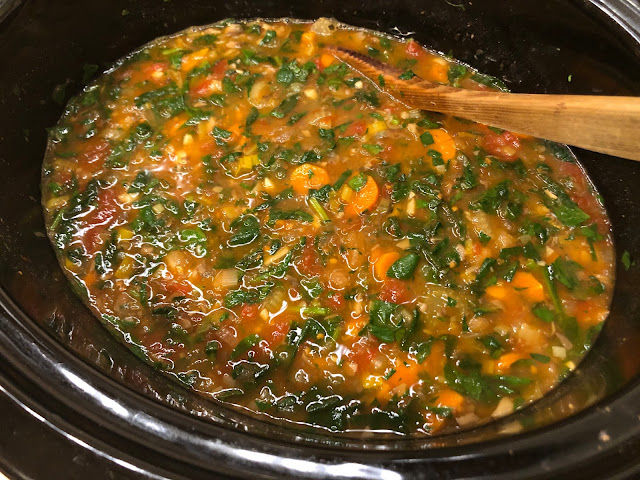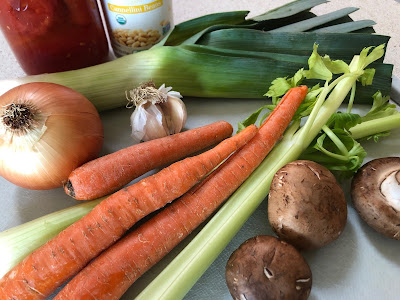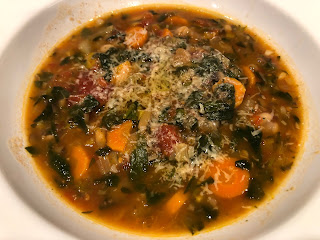
Recipe: Healthy comfort food makes the most of harvest basics
 |
| With the spinach added, the ribollita is about ready to serve. (Photos: Kathy Morrison) |
Onions, carrots, tomatoes and garlic: How basic can you get? But it's all in how they work together that makes ribollita, a delicious Italian vegetable bean soup that's perfect for fall.
Ribollita is Tuscany's version of minestrone. The name comes from the Italian for "reboiled." In other words, leftovers. Like many soups, it's even better the next day. It also freezes beautifully. I usually simmer it in my slow cooker, which is about as carefree as anything that starts with fresh vegetables. And this is my note to myself across the top of the recipe: "Double this because you'll wish you had."
I adapted this recipe from "The Slow Cook Book" by Heather Whinney (DK, 2011) and love its versatility. The vegetable combination can be tailored to personal taste. The four vegetables mentioned in my first paragraph are the only musts for this -- you'll see that there are a lot of possibilities beyond those. And don't skimp on the black pepper -- this recipe really takes to it.
This soup makes a great vegetarian supper or lunch. If you use vegetable broth instead of chicken and skip the Parmesan, it's vegan. The toasted bread adds an important texture to the soup as served, so use a gluten-free bread if you're a GF cook.

|
|
.
|
Ribollita
Serves 4 to 6
Ingredients :
2 tablespoons olive oil, plus more for drizzling
1 onion, chopped
2 or 3 carrots, peeled and sliced
1 leek, trimmed and sliced
2 celery stalks, trimmed and sliced (optional)
5 to 6 brown (cremini) mushrooms, chopped (optional)
Salt and freshly ground black pepper
2 garlic cloves, crushed and chopped
One 14-ounce can crushed tomatoes or 1 pint home-canned tomatoes, chopped
1 tablespoon tomato paste
1/2 teaspoon or more crushed dried oregano
3 cups chicken or vegetable stock, heated
One or two 14-ounce cans cannellini beans, drained and rinsed
At least 4 and up to 8 cups baby spinach leaves, shredded (one 5-ounce bag equals 8 cups)
1/4 chopped fresh Italian parsley, optional
One or two slices per serving of artisan bread such as ciabatta, pugliese or sourdough
Grated Parmesan cheese, for serving
Other vegetables that can substitute: Use 2 shallots for the leek; 1 or 2 zucchini, trimmed and sliced, instead of the celery; chard or mixed greens for the spinach.
Instructions:
Heat the 2 tablespoons oil in a large deep saucepan over low heat. Add the onion, carrots, leek or shallots and (if using) the celery and mushrooms. Cook for 10 minutes until softened but not colored. Season with salt and pepper, and stir in the garlic; cook for 1 minutes. Add the tomatoes, tomato paste, oregano and stock, and bring to a boil.
If using a slow cooker: Transfer everything to the slow cooker and adjust the seasoning. Mash half the beans with a fork, then stir them into the soup along with the remaining whole beans. Cover with the lid and cook on High for 3 to 4 hours or Low for 5 to 6 hours.
When there's about 20 minutes of cooking time remaining, check the seasoning again and then stir in the spinach. Stir in the parsley, if using, just before serving.
Toast the bread until golden brown. Place one or two pieces in serving bowls (it will depend on how big the slices and the bowls are). Drizzle the toast with a bit of olive oil, and then ladle the soup over the toast. Garnish with Parmesan and another drizzle of olive oil.

|
To cook on the stove: Keep the soup in the original pot. Follow the above directions up to the point of adding the beans. Then lower the heat, stir in only the mashed beans, and continue cooking for 30 minutes.
Add the remaining beans and the spinach (after testing the seasoning) and continue simmering for another 30 minutes.
Leftover soup, as mentioned, can be augmented and "recooked," or frozen without the bread for up to 3 months.
Comments
0 comments have been posted.Sacramento Digs Gardening to your inbox.
Food in My Back Yard Series
April 22: Should you stock up on fertilizer? (Yes!)
April 15: Grow culinary herbs in containers
April 8: When to plant summer vegetables
April 1: Don't be fooled by these garden myths
March 25: Fertilizer tips: How to 'feed' your vegetables for healthy growth
March 18: Time to give vegetable seedlings some more space
March 11: Ways to win the fight against weeds
March 4: Potatoes from the garden
Feb. 25: Plant a fruit tree now -- for later
Feb. 18: How to squeeze more food into less space
Feb. 11: When to plant? Consider staggering your transplants
Feb. 4: Starting in seed starting
Sites We Like
Garden Checklist for week of April 27
Once the clouds clear, get to work. Spring growth is in high gear.
* Set out tomato, pepper and eggplant transplants.
* From seed, plant beans, beets, cantaloupes, carrots, corn, cucumbers, melons, pumpkins, radishes and squash. Plant onion sets.
* In the flower garden, plant seeds for asters, cosmos, celosia, marigolds, salvia, sunflowers and zinnias. Transplant petunias, zinnias, geraniums and other summer bloomers.
* Plant perennials and dahlia tubers for summer bloom. Late April is about the last chance to plant summer bulbs, such as gladiolus and tuberous begonias.
* Transplant lettuce and cabbage seedlings.
* Weed, weed, weed! Don’t let unwanted plants go to seed.
* April is the last chance to plant citrus trees such as dwarf orange, lemon and kumquat. These trees also look good in landscaping and provide fresh fruit in winter.
* Feed citrus trees with a low dose of balanced fertilizer (such as 10-10-10) during bloom to help set fruit. Keep an eye out for ants.
* Apply slow-release fertilizer to the lawn.
* Thoroughly clean debris from the bottom of outdoor ponds or fountains.
* Start thinning fruit that's formed on apple and stone fruit trees -- you'll get larger fruit at harvest (and avoid limb breakage) if some is thinned now. The UC recommendation is to thin fruit when it is about 3/4 of an inch in diameter. Peaches and nectarines should be thinned to about 6 inches apart; smaller fruit such as plums and pluots can be about 4 inches apart. Apricots can be left at 3 inches apart. Apples and pears should be thinned to one fruit per cluster of flowers, 6 to 8 inches apart.
* Azaleas and camellias looking a little yellow? If leaves are turning yellow between the veins, give them a boost with chelated iron.
* Trim dead flowers but not leaves from spring-flowering bulbs such as daffodils and tulips. Those leaves gather energy to create next year's flowers. Also, give the bulbs a fertilizer boost after bloom.
* Pinch chrysanthemums back to 12 inches for fall flowers. Cut old stems to the ground.
* Mulch around plants to conserve moisture and control weeds.